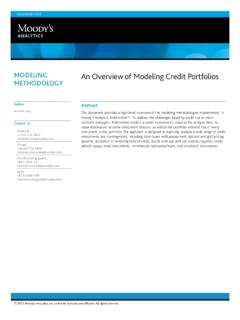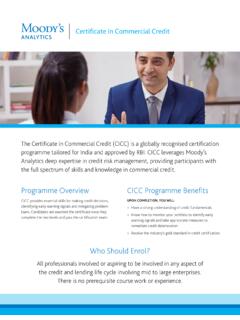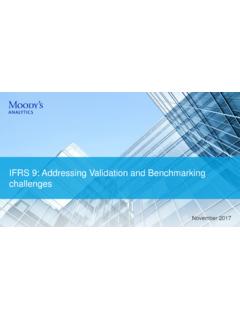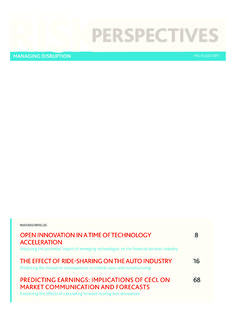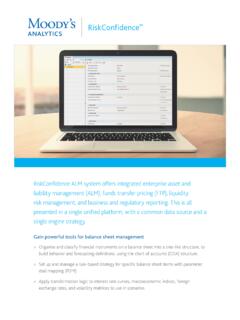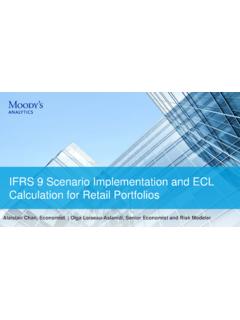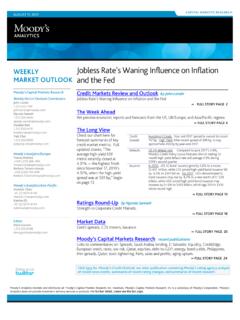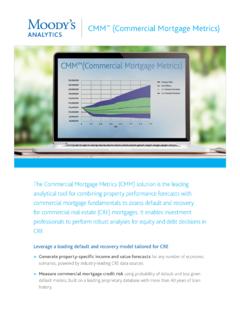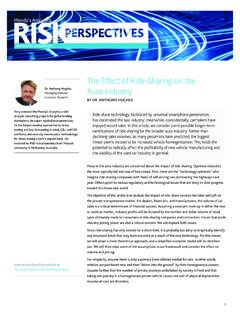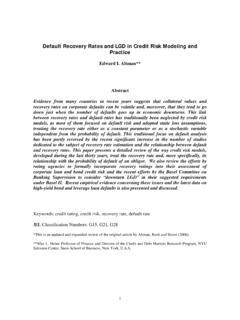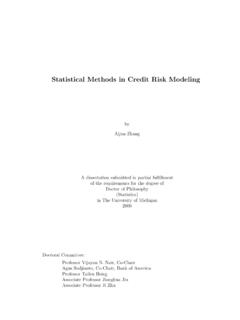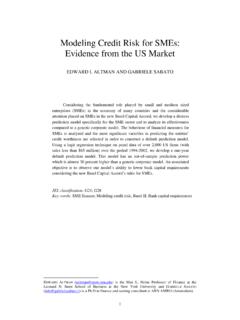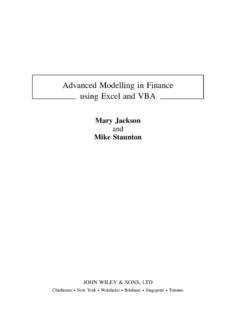Transcription of Investing in Corporate Credit Using Quantitative …
1 14 SEPTEMBER 2010 MODELING METHODOLOGY FROM MOODY S KMV Authors Zan Li Jing Zhang Editor Christopher Crossen Contact Us Americas +1-212-553-5160 Europe + Asia (Excluding Japan) +85 2 2916 1121 Japan +81 3 5408 4100 Investing in Corporate Credit Using Quantitative Tools Abstract Corporate Credit is an important investment class with potentially attractive returns. The asymmetric nature of Corporate bond returns implies that Investing in Credit is not about picking winners, but rather about avoiding losers ( , defaults and spreads blow-ups). Investors can utilize Quantitative measures of Credit risk to minimize the risk of such events. This paper demonstrates how investors can use Moody s Analytics EDF (Expected Default Frequency) Credit measures and fair-value spread (FVS) framework to minimize risk and exploit asset mispricing. We show that both investment grade and high yield portfolios constructed utilizing EDF measures and FVS criteria outperform their respective benchmarks, even after controlling for transaction costs.
2 Further, we develop portfolios consisting only of high yield bonds that outperform an investment grade index with less risk. We also show that portfolio weights significantly affect returns and risk trade-offs. While it is not the objective of this study to recommend specific investment strategies, our results suggest that Quantitative metrics such as EDF measures and FVS can be used as powerful tools for Investing in Corporate Credit . 2 Investing IN Corporate Credit Using Quantitative TOOLS 3 Table of Contents 1 Overview ..4 EDF Credit Measures and the FVS Framework .. 7 2 Data .. 8 Data Sources .. 8 3 Using EDF Credit Measures and FVS in Corporate Bond Investment .. 11 Constructing Portfolios that Outperform Benchmarks .. 11 Using High Yield Bonds to Construct Investment Grade-like Portfolios .. 29 4 Conclusion .. 33 Appendix A Fair-value Spread Framework .. 34 Appendix B Empirical Results for Europe.
3 36 References .. 43 4 1 Overview Corporate Credit presents potentially attractive investment opportunities. For example, the cumulative returns of the Merrill Lynch Corporate bond indices, both investment grade and high yield, are higher than those of the S&P 500 and the Dow Jones 30 during January 1990 January 2009. This is shown in Figure 1 and Figure 2, respectively. Figure 1 Cumulative returns of Merrill Lynch Corporate bond indices and the S&P 500 Figure 2 The cumulative returns of both the investment grade and high yield bond indices outperformed the Dow Jones 30 Index. 0%100%200%300%400%500%600%Jan-90 Jan-92 Jan-94 Jan-96 Jan-98 Jan-00 Jan-02 Jan-04 Jan-06 Jan-08 Jan-10 Cumulative Returns of Merril Lynch Corporate Bond Indices and S&P 500, 1990 2009S&P500 Investment GradeHigh Yield80%100%120%140%160%180%200%220%Jul- 99 Jun-00 Jun-01 Jun-02 Jun-03 Jun-04 Jun-05 Jun-06 Jun-07 Jun-08 Jun-09 Cumulative Returns of Merrill Lynch Corporate Bond Indices and Dow Jones 30, 1999 2009 Dow Jones 30 Investment GradeHigh Yield Investing IN Corporate Credit Using Quantitative TOOLS 5 While a rigorous comparison of the risk-adjusted returns of equities versus Corporate bonds falls beyond the scope of this paper, Figure 1 and Figure 2 remind us that Corporate Credit is an important and potentially attractive investment class.
4 Both equity and bonds represent claims on the underlying cash flows of the issuing firm, but their return distributions are quite different. In principle, an equity investor can lose everything, but potentially receive an unlimited upside. On the other hand, the best return a bondholder can achieve is the return of principal plus coupon, assuming the bond trades close to par. Distressed debt offers the possibility for high returns, but such issues perform more like equity because of their low prices relative to the principal and coupon. On the downside, a bondholder can lose both the principal and future coupons, minus the recovery. Because the downside is much more extreme, a number of positive returns followed by a large negative return can wipe out all previous gains. The different nature of equity and bond return distributions highlights an important difference in the investment approaches for each.
5 To illustrate this distinction, we conduct the following exercise: 1. Take the Merrill Lynch Investment Grade and High Yield indices. 2. Remove 10% of the bonds with the best and worst total returns each month. 3. Calculate the cumulative returns of the truncated indices. We complete the same exercise Using the Dow Jones 30 equity index. Figure 3 and Figure 4 show that truncation results in higher cumulative returns for the investment grade index and the high yield index during July 1999 January 2009. Figure 3 The truncated investment grade index achieves a higher cumulative return than the Original Index; the worst returns have a larger impact than the best returns. 100%110%120%130%140%150%160%170%180%190% Jul-99 Jul-00 Jul-01 Jul-02 Jul-03 Jul-04 Jul-05 Jul-06 Jul-07 Jul-08 Jul-09 Cumulative Returns Merrill Lynch Investment Grade Investment GradeInvestment Grade Truncated 6 Figure 4 The truncated high yield index achieves a much higher cumulative return than the Original Index due to the reduction in downside.
6 It is worth mentioning that the difference is even more pronounced for the high yield index. In contrast, Figure 5 shows that the truncated stock index underperforms the Original Index during the same period. Figure 5 The truncated stock index has a lower cumulative return than the Original Index. 80%100%120%140%160%180%200%220%240%260%J ul-99 Jul-00 Jul-01 Jul-02 Jul-03 Jul-04 Jul-05 Jul-06 Jul-07 Jul-08 Jul-09 Cumulative Returns Merrill Lynch High YieldHigh Yield High Yield Truncated60%80%100%120%140%160%180%Jul-9 9 Jun-00 Jun-01 Jun-02 Jun-03 Jun-04 Jun-05 Jun-06 Jun-07 Jun-08 Jun-09 Cumulative Returns Dow Jones 30 Dow Jones 30 Dow Jones 30 Truncated Investing IN Corporate Credit Using Quantitative TOOLS 7 This particular study in itself is not an investment strategy, since it is not possible to pinpoint the worst performers ex ante. Rather, our work illustrates the characteristics of the return distributions and the implications of Investing in these asset classes.
7 Unlike equity, Investing in Credit is not about picking winners, but rather about avoiding losers ( , avoiding defaults and spreads blow-ups). Another implication is the importance of diversification in Credit portfolios, because a few concentrated defaults can be extremely detrimental to a portfolio s performance. To avoid defaults and spreads blow-ups, investors can conduct a fundamental analysis of a borrower s Credit risk. An alternative and complementary approach is to utilize Quantitative measures of Credit risk. Our paper focuses on this subject. Specifically, we examine Using Moody's Analytics EDF measures and fair-value spread (FVS) framework to add value when Investing in Corporate credits. EDF Credit Measures and the FVS Framework We apply EDF Credit measures and use the FVS framework to construct portfolios with attractive return-risk trade-offs Using bonds in the Merrill Lynch Corporate bond indices.
8 We show that EDF measures and FVS can help improve Corporate Credit portfolio performance by controlling for risk and/or exploiting relative value opportunities. Both investment grade and high yield portfolios constructed Using EDF measures and FVS criteria outperform their respective benchmarks in multiple measures, including average annual return, standard deviation, and cumulative return over the long run, while controlling downside risk. We achieve superior performance by controlling for Credit risk. Exploiting relative value opportunities offers the potential to add additional returns. These results hold true for both and European Corporate bonds. Similar strategies can also be used to construct model portfolios consisting only of high yield bonds that outperform an investment grade index with the same multiple measures. Furthermore, these strategies performed well during the crisis period in 2007 and 2008.
9 To make our exercise more realistic, we factor transaction costs into our study. The EDF Credit measure is calculated Using a structural framework conceptually similar to the Black-Scholes-Merton (BSM) Moody s Analytics implements the Vasicek-Kealhofer (VK) version of this model to calculate the EDF Credit Over the past two decades, the EDF Credit measure has become the de facto standard for market-based Quantitative measurement of default risk and has proved to be a powerful and forward-looking indicator of Corporate Beyond predicting defaults, another important application of any Quantitative Credit risk measure is valuing Credit instruments such as Corporate bonds, loans, and Credit derivatives. Moody s Analytics FVS framework represents such an important application. With the EDF metric as the measure of default risk, the FVS framework incorporates recovery risk, market risk premium, term, and other drivers to derive a modeled spread for the instrument being the constructed portfolios show superior performance relative to their benchmarks, it is important to note that it is not our objective to recommend any specific investment strategy in this study.
10 Our intention is to demonstrate that Quantitative tools such as EDF measures and FVS can add value to the process of Investing in Corporate Credit . In addition to fundamental analysis, portfolio managers and analysts can use these tools to screen for early warning, to identify problematic names and sectors, and to spot relative value opportunities. This modeled spread can be compared with the observed spread, and the gap can be used as a relative value indicator in the investment process. 1 See Black and Scholes (1973), and Merton (1974) for modeling Corporate liabilities. 2 See Kealhofer (2003a) for details. 3 See Miller (1998), Dwyer and Korablev (2007), and Korablev and Qu (2009). 4 See Appendix A for the details of the framework. 8 2 Data Before we discuss how we construct these portfolios, we first present our data sources.
